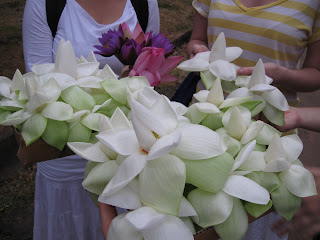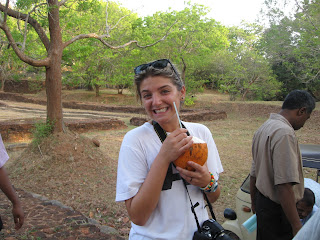I’m back in Kandy after a fun but exhausting week to Anuradhapura, Sigiriya, and Polonnaruva. Everyday was spent visiting ruins and museums, and I’m not sure I’ve ever done quite so much sight-seeing in one week. Thankfully, we were given a few hours to rest during the middle of the day when it really was too hot to move. I’m not sure exactly how high the temperature got, but according to the thermometer on my alarm clock, it was about 29-30 degrees in the middle of the night (that would be Celsius. In Fahrenheit, that’s the mid 80s)—not the most comfortable temperatures for sleeping. There were a few days that we were able to swim during our long lunch break, which was very nice. At all of the sites we visited, we had discussions on the historical significance of the site, the current cultural and environmental issues regarding the site, or how ancient culture has influenced the current cultural, social, and political issues in Sri Lanka.
Despite the heat and busy schedule, the trip was very enjoyable. We left on Monday to drive to Anuradhapura, the ancient royal capital of Sri Lanka. We stopped en route at Ibbankatuwa, an Early Iron Age burial site, where I earned myself free ice cream by finding the hidden symbol on one of the gravestones.
Sudharshan, our archaeology professor talking about Ibbankantuwa
The symbol on the gravestone--a square with an antenna
On Monday afternoon, in Anuradhapura, we saw the citadel, Vessagiri, the Sri Maha Bodhi, and Ruwanveliseya. Vessagiri was a very cool place with a bunch of overhanging rocks, under which the forest-dwelling monks of the 3rd century BCE meditated. The Sri Maha Bodhi (Sacred Tree of Enlightenment, which is said to have come from the Bodhi tree in India under which the Buddha attained enlightenment) and Ruwanveliseya (The Great Stupa) are both very sacred Buddhist sites and were quite magnificent to see. Tuesday, we visited several museums, stupas, and other archaeological sites at Anuradhapura. On Wednesday, we saw Mihintale, a monastic complex at Anuradhapura, which is also the place that Buddhism is said to have first been introduced to Sri Lanka. We first went to a pristine and beautiful meditation center, then drove a short distance to a big rock, which we climbed up for views of the entire city.
In one of the drip ledge caves that protected the monks from rain
Lotus flowers to put on the altar at the Sri Maha Bodhi
The Great Stupa
Our driver, Sumanasena, tries out the bathtub at a monastic hospital
We left Anuradhapura on Thursday and drove to Sigiriya, a palace complex built on top of a huge rock. After visiting the Sigiriya Museum, we climbed and scrambled up Pidurangala Rock, right next to Sigiriya. On Friday we hiked up Sigiriya itself.
At the top of Pidurangala. Sigiriya is in the background.
Frescoes on the way up Sigiriya
At the top of Sigiriya
All of the hiking and climbing was a lot of fun, but it’s really exhausting in the heat. Coconut water makes everything better though.
Alex with her coconut
On Saturday, we drove a couple hours to Polonnaruva and somehow managed to visit the museum, citadel complex, Sacred Quadrangle, Hindu shrine, monastery, Buddhist shrine, lotus pond, and Potgul Vehara (huge rock carving consisting of a seated, a standing, and a reclining Buddha), spread out all across the city. To use the word of one of my fellow ISLE students, we were all pretty “stupa-fried” by the end, but I learned a lot and enjoyed myself, and Sudarshan, our archaeology professor is a really great teacher.
An ancient toilet in Polonnaruva
The seated Buddha image at the Potgul Verhara
Not only have I been learning about ancient Sri Lankan culture, but I’ve also been participating in several current cultural activities. Last weekend, before leaving for the Northern Tour, I went with my host family to a Buddhist prayer meeting, called a Pirith. There were several monks who led us all in prayer and meditation and, at the end, gave everyone a pirith string, which is tied around the wrist and is supposed to give protection. My family also took me to the homecoming party for the wedding of my amma’s brother’s wife’s sister’s daughter (“close relations,” according to my amma). The homecoming happens several days after the wedding and is basically a catered lunch during which the bride and groom greet all of the guests and get their picture taken with all of their various family members. Although living with a host family is not always easy, it’s definitely giving me good insight into Sri Lankan culture, and Kandy is beginning to feel more and more like home, especially after spending a week on the road.












No comments:
Post a Comment